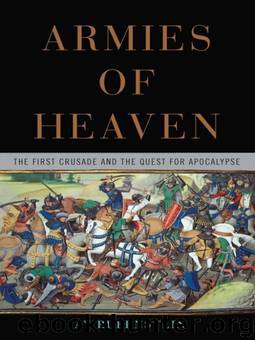Armies of Heaven: The First Crusade and the Quest for Apocalypse by Jay Rubenstein

Author:Jay Rubenstein [Rubenstein, Jay]
Language: eng
Format: epub
Publisher: Basic Books
Published: 2011-11-01T00:00:00+00:00
Siege warfare as depicted in the Bayeux Tapestry—violent but on a small scale (Scala/White Images/Art Resource, NY)
Even in the worst cases, however, the small scale of the fortifications would have limited fatalities. Large castles, like William the Conqueror’s White Tower in London, were unusual. In the eleventh century, most European fortresses were tall, narrow structures made of stone or wood. They were intended to provide shelter for aristocrats as they went about their business of plundering and terrorizing their own subjects. Such buildings were incapable of sheltering a large number of people, and they certainly would not have enabled casualties comparable to those of any of the great battles of the crusade.4
A possible exception to these rules is the siege of Beneciacum, a brutal massacre that, like the crusade, grew out of a spirit of peace. Around the year 1038, Aimo, Archbishop of Bourges, imposed an oath of peace upon everyone in his archdiocese over the age of fifteen. With all their hearts, they swore on the relics of St. Stephen, the first martyr, to fight against plunderers of church goods; against oppressors of monks, nuns, and clerics; and against anyone who would assail their mother church. “You would have looked upon the army,” the source for the story, a monk named Andrew, observed, “as if another Israelite people.” Composed of ordinary folk dedicated to peace, it proved itself an effective militia. “Fear and dread of them so filled the hearts of the unbelievers that they trembled before this unarmed multitude of commoners as if it were a division of trained soldiers.” But their achievements were fleeting. Archbishop Aimo overreached his authority and with no real cause accused a castellan named Stephen of Beneciacum of breaking the peace. The church’s army besieged his castle, where all of the locals—also mainly commoners—had fled inside its walls. Archbishop Aimo, indifferent to the cost, ordered the fortification set afire. According to Andrew (probably with some exaggeration), 1,400 people died, many pregnant women among them. Stephen survived and was confined to the archbishop’s prison.5
Later another castellan named Odo utterly destroyed the peace army. In this battle at least seven hundred clergy died, and so many of their corpses filled a river that they functioned as an effective bridge. Their spears were left eerily stuck into the ground along the banks, like young trees at the edge of a forest. Although exaggerations are likely in both cases, these two battles were nonetheless remembered as massacres. They resembled the crusade in at least two other respects as well: A bishop had formally proclaimed the need for war, and the soldiers who formed the army fought together in the name of God and of peace. Given the typically small scale of European warfare in the eleventh century, these battles were traumatic for eyewitnesses, though the numbers of dead were in no way comparable to those of any of the major crusade battles.6
Aimo’s story raises one other important point. When medieval observers were trying to contextualize battles that
Download
This site does not store any files on its server. We only index and link to content provided by other sites. Please contact the content providers to delete copyright contents if any and email us, we'll remove relevant links or contents immediately.
| Africa | Americas |
| Arctic & Antarctica | Asia |
| Australia & Oceania | Europe |
| Middle East | Russia |
| United States | World |
| Ancient Civilizations | Military |
| Historical Study & Educational Resources |
Room 212 by Kate Stewart(4111)
The Crown by Robert Lacey(4109)
Endurance: Shackleton's Incredible Voyage by Alfred Lansing(3850)
The Iron Duke by The Iron Duke(3642)
The Rape of Nanking by Iris Chang(3518)
Killing England by Bill O'Reilly(3459)
Joan of Arc by Mary Gordon(3262)
Say Nothing by Patrick Radden Keefe(3066)
I'll Give You the Sun by Jandy Nelson(2843)
Hitler's Monsters by Eric Kurlander(2735)
Shadow of Night by Deborah Harkness(2722)
Margaret Thatcher: The Autobiography by Thatcher Margaret(2687)
Mary, Queen of Scots, and the Murder of Lord Darnley by Alison Weir(2679)
Darkest Hour by Anthony McCarten(2649)
Blood and Sand by Alex Von Tunzelmann(2610)
Red Famine: Stalin's War on Ukraine by Anne Applebaum(2467)
Eleanor & Park by Rainbow Rowell(2396)
The One Memory of Flora Banks by Emily Barr(2349)
Book of Life by Deborah Harkness(2267)
